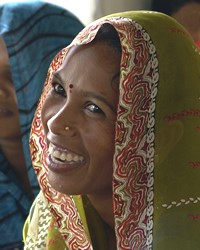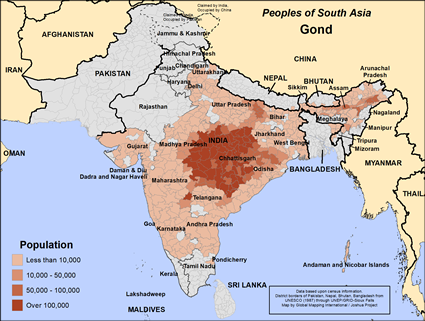Gond unspecified in India

Photo Source:
Yann Forget - Wikimedia
Creative Commons
|

Map Source:
People Group data: Omid. Map geography: UNESCO / GMI. Map Design: Joshua Project.
|
| People Name: | Gond unspecified |
| Country: | India |
| 10/40 Window: | Yes |
| Population: | 14,278,000 |
| World Population: | 14,289,000 |
| Primary Language: | Hindi |
| Primary Religion: | Hinduism |
| Christian Adherents: | 0.91 % |
| Evangelicals: | 0.00 % |
| Scripture: | Complete Bible |
| Ministry Resources: | Yes |
| Jesus Film: | Yes |
| Audio Recordings: | Yes |
| People Cluster: | South Asia Tribal - Gond |
| Affinity Bloc: | South Asian Peoples |
| Progress Level: |
|
Introduction / History
A crude gate on the mud road, the wooden poles on both the sides and the beam across it stands high enough for anyone to enter. There are remains of bundles and ropes hung on it. Among them you may find a new bundle of shrinking animal skin. If you see these before a village, you can be sure: you are entering a Gondi village.
Gonds celebrate their legacy every year during the Dasara. On that occasion, all the living heirs of the crown in each generation are honored by carrying them on a pallak (royal cart carried on shoulders).
What Are Their Lives Like?
Gonds are agriculturists and choose to live on the riverbeds close to forests. Most of them possess agricultural land. Those who have a god portion of the land cultivate rice, javar (cereals) and green dal (pulses). Tending goats and cattle are also common. Poorer Gonds work in the fields of the richer Gonds. There is not much work available for them except in farming seasons. They earn a meager daily wage. They love hunting and wild meats are their favorites.
Southern Gonds live in clusters. Each village will have 25 to 30 huts and is surrounded by their fields. Villages will be two to four kilometers away from one another. From one village to another or to the nearby town, they travel by bullock-carts. All farmers offer sacrifices at the end of each harvest. The size of the yield determines the size of the animal offered. A good harvest may demand a goat and poorer, a chicken. Pigs are also sacrificed for a moderate harvest. For them, monsoon not only brings showers but also sicknesses.
Girls are married between the age of 13 and 15. Marriages are during the summer. A girl and a boy in love can run away together; this is an accepted custom. Once they come back, the local panchayat meet to discuss the terms and conditions of the marriage. Marriages are also arranged by the parents. Depending up on the financial conditions of the families the bride groom's parents must give the bride's parents some amount of money.
Among the southern Gond tribes, there are seven clans. Each clan has gods numbering from one to seven. They maintain their identity and distinguish one clan form another based on the number of gods each has. People of the same clan cannot get married. When one meet someone, he asks, how many gods the other person has in his clan. This is how they know whether they belong to the same clan or not. Clans with the same number of gods will not get married together. This is observed strictly. If the financial condition permits, one is allowed to have more than one wife.
What Are Their Beliefs?
They believe that evil spirits are the causes for sicknesses. They believe sacrifices keep away these evil spirits. Perumal, the high-priest, responsible for three or four villages together, offers these sacrifices for every village. The sacrifice will be followed by a social dinner. The sacrificial goat must give permission for the sacrifice by nodding its head! The people will wait till the animal does it.
The sacrifice is witnessed by the whole of the village. But the dinner made by cooking the animal will be enjoyed only by the men. All the men gather at the riverside to prepare the dinner. White toddy from palm or the country liquor called, black toddy may supplement the diner. Drinking, in general, is not just the right of men. The sacrifice animal's skin is stuffed with hay and hung on the village gate. This is to frighten the evil spirits and give courage to the villagers. The Southern Gonds prefer witch doctors even when a Public Health Centre is accessible. They will have to carry a chicken along. Gonds think that enemies' witchcraft brings them ill health. Herbs or water is given by the witch doctor as remedies.
What Are Their Needs?
Gond people need protection from the spirit world. They can only get this through Jesus Christ. They also need better ways to make a living. As it stands, they live at a subsistence level.
Prayer Points
Pray for the Lord to soften the hearts of Gond leaders and family heads, sending broken-hearted ambassadors to help them begin a spiritual journey that will lead to a Gond movement to Christ in India.
Pray for the Lord to reveal the hope of his son to Gond families and clans.
Pray for an unstoppable Disciple Making Movement.